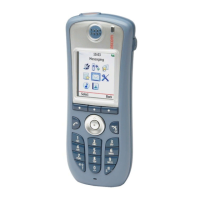TD 92685EN
28 June 2012 / Ver. A
Troubleshooting Guide
Ascom i62 VoWiFi Handset
21
3. The VoWiFi Handset as
3.8.1 SIP Components
SIP Proxy Servers
SIP servers receive requests from clients, process the
requests and generate responses. A SIP
server is usually a proxy server acting on behalf of the client by receiving and forwarding the
requests to the recipient, receiving responses from the recipient and returning these to the
client. Because the address of the recipient is not initially known when a request is initiated,
a proxy server often contains a registrar server where location details of all the users
registered with the network are contained.
SIP Clients
In general the notion of clients refers to the end users of applications running at the
appl
ication layer of the TCP/IP protocol stack. The applications include softphone
applications and voice and messaging applications for IP handsets.
SIP Registration Servers
One of the most important functions of SIP servers is to detect the location of users in the
network and process request
s from clients to register their current location. Users register
their IP addresses with a server by sending a REGISTER message to the server informing
them of their IP address. The server subsequently returns an acknowledgement in the form
of a 200 OK message when the user IP address is registered.
The server is connected to a location datab
ase where an up-to-date mapping between the
server, user and user IP address is maintained. The specific mapping is between the user
Address of Record (AOR) and the user IP address, for example sip:user2@serverb.com ->
172.20.15.235. This mapping is refreshed on a periodical basis by REGISTER messages
according to a negotiated expiry value between the client and server.
SIP Addressing
SIP uses email-style addresses to identify users, for example
:
• Harry.Burger@millpond.se
• freddy@serverb.com
• 4112@serverb.com
• user2@serverb.com
• user1@servera.com
The SIP Uniform Resource Identifier (URI) defines
the addressing scheme used to call parties
via SIP and is written as:
sip:x@y[:Port]
For example:
sip:4112@serverb.com:5060
Parameters may also be added to addresses such a
s type or transport protocol. For example:
sip:user2@serverb.com;transport=tcp
SIP Ports
SIP provides the signaling part of
a communication session. signaling information may be
encrypted or non encrypted.
SIP clients send and receive non-encrypted signaling information in UDP or TCP packets to
and from other SIP servers and SIP endpoints on the default port 5060.

